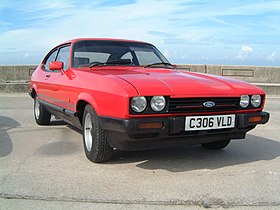Ford Capri RS 2600
| Ford Capri | |
|---|---|

1986 Ford Capri Mk III Laser
|
|
| Overview | |
| Manufacturer | Ford Europe |
| Production | 1969–1986 |
| Designer | Philip T. Clark |
| Body and chassis | |
| Class | Mid-size coupé |
| Related | Ford Cortina |
| Chronology | |
| Successor | Ford Puma |
| Ford Capri Mk I | |
|---|---|

1969 Ford Capri 1600 "Mark 1"
|
|
| Overview | |
| Manufacturer | Ford of Europe |
| Also called | Mercury Capri |
| Production | 1969–1974 |
| Assembly |
|
| Body and chassis | |
| Class | Mid-size sports car |
| Body style | Fastback coupé |
| Layout | FR layout |
| Related | Ford Cortina Mk II |
| Powertrain | |
| Engine | |
| Transmission | 4-speed manual all-synchromesh |
| Dimensions | |
| Wheelbase | 100.8 in (2,560 mm) |
| Length | 168.5 in (4,280 mm) |
| Width | 64.8 in (1,646 mm) |
| Height | 50.7 in (1,288 mm) |
| Curb weight |
|
| Chronology | |
| Successor | Ford Capri Mk II |
| Ford Capri Mk II | |
|---|---|

1977 Capri II 3000 Ghia
|
|
| Overview | |
| Manufacturer | Ford of Europe |
| Also called | Mercury Capri |
| Production | 1974–1978 |
| Assembly |
Dagenham, Halewood, United Kingdom Genk, Belgium Saarlouis, Cologne, Germany |
| Body and chassis | |
| Class | Mid-size sports car |
| Body style | Hatchback coupé |
| Layout | FR layout |
| Powertrain | |
| Engine | 1.3 L Crossflow I4 1.6 L Crossflow I4 1.6 L Pinto TL16 I4 2.0 L Cologne V6 2.0 L Pinto TL20 I4 2.3 L Cologne V6 3.0 L Essex V6 |
| Transmission | 4-speed manual 3-speed automatic |
| Dimensions | |
| Wheelbase | 100.7 in (2,559 mm) |
| Length | 166.9–169.8 in (4,240–4,313 mm) |
| Width | 66.9 in (1,698 mm) |
| Height | 53.4 in (1,357 mm) |
| Curb weight | 2,149.5–2,513.3 lb (975–1,140 kg) |
| Chronology | |
| Predecessor | Ford Capri Mk I |
| Successor | Ford Capri Mk III |
| Ford Capri Mk III | |
|---|---|

Ford Capri III S
|
|
| Overview | |
| Manufacturer | Ford of Europe |
| Production | 1978–1986 |
| Assembly |
Genk, Belgium Cologne, Saarlouis, Germany |
| Body and chassis | |
| Class | Mid-size sports car |
| Body style | Hatchback coupé |
| Layout | FR layout |
| Powertrain | |
| Engine | 1.3 L Crossflow I4 1.6 L Pinto TL16 I4 2.0 L Cologne V6 2.0 L Pinto TL20 I4 2.3 L Cologne V6 2.8 L Cologne V6 3.0 L Essex V6 |
| Transmission |
Manual transmission, Automatic transmission |
| Dimensions | |
| Wheelbase | 101 in (2,565 mm) |
| Length | 167.8 in (4,262 mm) |
| Width | 67 in (1,702 mm) |
| Height | 51 in (1,295 mm) |
| Curb weight | 2,227 lb (1,010 kg) 1.3L 2,293 lb (1,040 kg) 1.6S 2,273 lb (1,031 kg) 2.0S 2,620 lb (1,188 kg) 2.8i 2,688 lb (1,219 kg) 3.0S |
| Chronology | |
| Predecessor | Ford Capri Mk II |
 |
|||||||
| Category | Group 5 | ||||||
|---|---|---|---|---|---|---|---|
| Constructor | Zakspeed, Ford Motorsport | ||||||
| Technical specifications | |||||||
| Chassis | Alloy tube structure with alloy sheet floorplan, bonded to kevlar bodypanels | ||||||
| Suspension (front) | Alloy wishbones, titanium concentric coil spring, gas dampers | ||||||
| Suspension (rear) | Alloy rear axle, radius locating arms, Watts linkage, titanium concentric coil spring, gas dampers | ||||||
| Engine | Based on Cosworth BDA-Turbo 1426 cc I-4 twin-turbo, FR | ||||||
| Transmission | Getrag 5-speed ZF LSD with 90 percent locking efficiency | ||||||
| Tyres |
Goodyear 10.0/225 × 16 (front); 12.5/225 × 19 (rear) |
||||||
| Competition history | |||||||
| Notable entrants | Ford Motorsport | ||||||
| Notable drivers | Klaus Ludwig, Jochen Mass | ||||||
| Debut | 1981 Group5 Season | ||||||
|
|||||||
The Ford Capri is a fastback coupé that was built by Ford Motor Company from 1969 to 1986, It was designed by American Philip T. Clark, one of the main designers of the Ford Mustang, which until 2010 was an unknown fact. Using the mechanical components from the Mk2 Ford Cortina and intended as the European equivalent of the Ford Mustang, the Capri went on to be a highly successful car for Ford, and sold nearly 1.9 million units in its lifetime. A wide variety of engines were used in the Capri throughout its production lifespan, which included the Essex and Cologne V6 s at the top of the range, whilst the Kent straight-four and Taunus V4 engines were used in lower specification models. Although the Capri was not officially replaced by any Ford model, the second-generation Probe was effectively its replacement after the later car's introduction to the European market in 1992.
The first Ford Capri was introduced in January 1969 at the Brussels Motor Show, with sales starting the following month. The intention was to reproduce in Europe the success Ford had had with the North American Ford Mustang; to produce a European pony car. It was mechanically based on the Cortina and built in Europe at the Dagenham and Halewood plants in the United Kingdom, the Genk plant in Belgium, and the Saarlouis and Cologne plants in Germany. The car was named Colt during its development stage, but Ford was unable to use the name, as it was trademarked by Mitsubishi.
...
Wikipedia
